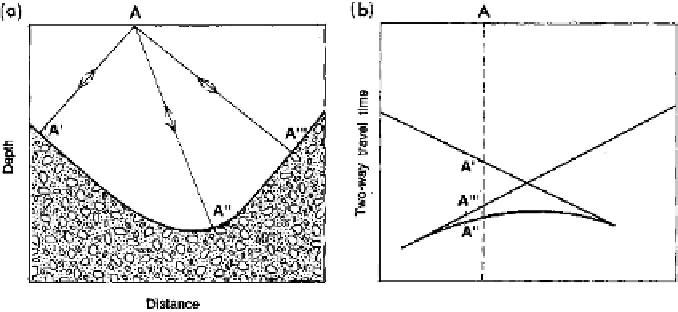Geoscience Reference
In-Depth Information
(a)
(b)
A
A
A'
A'''
A'
A'''
A''
A''
Distance
Distance
Figure 4.48.
(a) A syncline with a centre of curvature (focus) that is below the
Earth's surface gives three normal-incidence reflections for shot/receiver locations
over the central part of the syncline. A shot/receiver location at A has reflections
from points A', A' and A''', one from each flank of the syncline and the third from the
centre. The extreme example of a syncline is two planes intersecting - there is
diffraction from the intersection. (b) Travel times for the syncline shown in (a).
The deeper the centre of curvature (the tighter the syncline), the broader the
convex reflection from the central portion of the syncline. Thus, on a
record section, a syncline can look much like an anticline. The process of migration
uses these three reflection branches to determine the shape of the reflecting surface,
the syncline.
Diffractions can be mistaken for reflections. Curved interfaces can also produce
some rather strange reflections (Fig. 4.48).
Migration is the name given to the process which attempts to deal with all
of these problems and to move the reflectors into their correct spatial locations.
Thus, diffractions are removed. They are recognized as being diffractions by a
method similar to the method of estimating the best stacking velocity; that is, if
they lie on a hyperbola, they are diffractions and are coalesced into a point at its
apex. Dipping layers are plotted correctly, multiples (reflections bouncing twice
or more in a layer) are removed and the reflections from curved interfaces are
inverted. There are many methods by which migration is performed, all of them
complex; the interested reader is referred to a reflection-processing text such as
Robinson and Treitel (1980), Hatton
et al
.(1985)orYilmaz (2001) for more
details.
Resolution of structure
The resolution of structure obtainable with reflection profiling is controlled by the
wavelength of the source signal. A wave of frequency 20 Hz travelling through
material with a P-wave velocity of 4.8 km s
−
1
has a wavelength of 240 m. When









